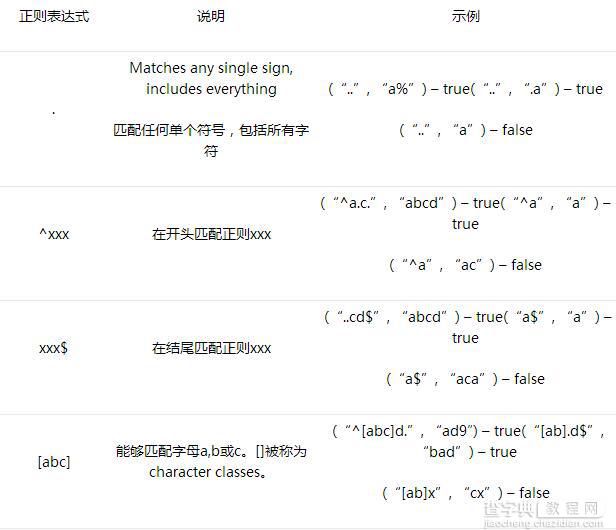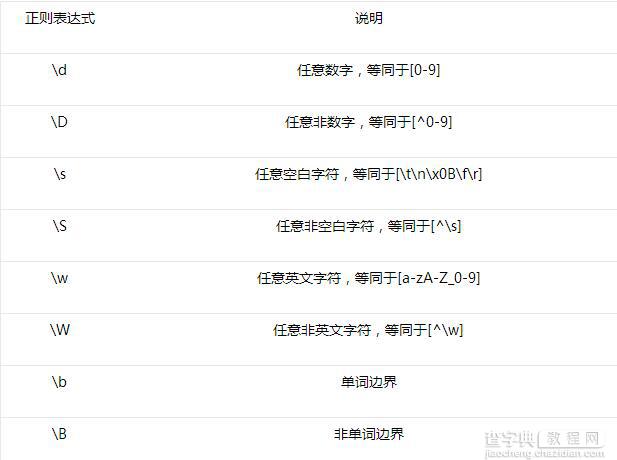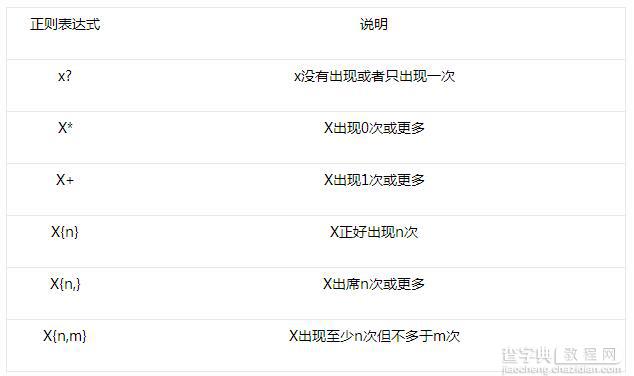本教程旨在帮助你驾驭Java正则表达式,同时也帮助我复习正则表达式。
什么是正则表达式?
正则表达式定义了字符串的模式。正则表达式可以用来搜索、编辑或处理文本。正则表达式并不仅限于某一种语言,但是在每种语言中有细微的差别。Java正则表达式和Perl的是最为相似的。
Java正则表达式的类在 java.util.regex 包中,包括三个类:Pattern,Matcher 和 PatternSyntaxException。
Pattern对象是正则表达式的已编译版本。他没有任何公共构造器,我们通过传递一个正则表达式参数给公共静态方法 compile 来创建一个pattern对象。
Matcher是用来匹配输入字符串和创建的 pattern 对象的正则引擎对象。这个类没有任何公共构造器,我们用patten对象的matcher方法,使用输入字符串作为参数来获得一个Matcher对象。然后使用matches方法,通过返回的布尔值判断输入字符串是否与正则匹配。
如果正则表达式语法不正确将抛出PatternSyntaxException异常。
让我们在一个简单的例子里看看这些类是怎么用的吧
package com.journaldev.util; import java.util.regex.Matcher; import java.util.regex.Pattern; public class RegexExamples { public static void main(String[] args) { // using pattern with flags Pattern pattern = Pattern.compile("ab", Pattern.CASE_INSENSITIVE); Matcher matcher = pattern.matcher("ABcabdAb"); // using Matcher find(), group(), start() and end() methods while (matcher.find()) { System.out.println("Found the text "" + matcher.group() + "" starting at " + matcher.start() + " index and ending at index " + matcher.end()); } // using Pattern split() method pattern = Pattern.compile("W"); String[] words = pattern.split("one@two#three:four$five"); for (String s : words) { System.out.println("Split using Pattern.split(): " + s); } // using Matcher.replaceFirst() and replaceAll() methods pattern = Pattern.compile("1*2"); matcher = pattern.matcher("11234512678"); System.out.println("Using replaceAll: " + matcher.replaceAll("_")); System.out.println("Using replaceFirst: " + matcher.replaceFirst("_")); } }
既然正则表达式总是和字符串有关, Java 1.4对String类进行了扩展,提供了一个matches方法来匹配pattern。在方法内部使用Pattern和Matcher类来处理这些东西,但显然这样减少了代码的行数。
Pattern类同样有matches方法,可以让正则和作为参数输入的字符串匹配,输出布尔值结果。
下述的代码可以将输入字符串和正则表达式进行匹配。
String str = "bbb"; System.out.println("Using String matches method: "+str.matches(".bb")); System.out.println("Using Pattern matches method: "+Pattern.matches(".bb", str));
所以如果你的需要仅仅是检查输入字符串是否和pattern匹配,你可以通过调用String的matches方法省下时间。只有当你需要操作输入字符串或者重用pattern的时候,你才需要使用Pattern和Matches类。
注意由正则定义的pattern是从左至右应用的,一旦一个原字符在一次匹配中使用过了,将不会再次使用。
例如,正则“121”只会匹配两次字符串“31212142121″,就像这样“_121____121″。
正则表达式通用匹配符号


Java正则表达式元字符

有两种方法可以在正则表达式中像一般字符一样使用元字符。
在元字符前添加反斜杠()
将元字符置于Q(开始引用)和E(结束引用)间
正则表达式量词
量词指定了字符匹配的发生次数。

量词可以和character classes和capturing group一起使用。
例如,[abc]+表示a,b或c出现一次或者多次。
(abc)+表示capturing group “abc”出现一次或多次。我们即将讨论capturing group。
正则表达式capturing group
Capturing group是用来对付作为一个整体出现的多个字符。你可以通过使用()来建立一个group。输入字符串中和capturing group相匹配的部分将保存在内存里,并且可以通过使用Backreference调用。
你可以使用matcher.groupCount方法来获得一个正则pattern中capturing groups的数目。例如((a)(bc))包含3个capturing groups; ((a)(bc)), (a) 和 (bc)。
你可以使用在正则表达式中使用Backreference,一个反斜杠()接要调用的group号码。
Capturing groups和Backreferences可能很令人困惑,所以我们通过一个例子来理解。
System.out.println(Pattern.matches("(wd)1", "a2a2")); //true System.out.println(Pattern.matches("(wd)1", "a2b2")); //false System.out.println(Pattern.matches("(AB)(Bd)21", "ABB2B2AB")); //true System.out.println(Pattern.matches("(AB)(Bd)21", "ABB2B3AB")); //false
在第一个例子里,运行的时候第一个capturing group是(wd),在和输入字符串“a2a2″匹配的时候获取“a2″并保存到内存里。因此1是”a2”的引用,并且返回true。基于相同的原因,第二行代码打印false。
试着自己理解第三行和第四行代码。:)
现在我们来看看Pattern和Matcher类中一些重要的方法。
我们可以创建一个带有标志的Pattern对象。例如Pattern.CASE_INSENSITIVE可以进行大小写不敏感的匹配。Pattern类同样提供了和String类相似的split(String) 方法
Pattern类toString()方法返回被编译成这个pattern的正则表达式字符串。
Matcher类有start()和end()索引方法,他们可以显示从输入字符串中匹配到的准确位置。
Matcher类同样提供了字符串操作方法replaceAll(String replacement)和replaceFirst(String replacement)。
现在我们在一个简单的java类中看看这些函数是怎么用的。
package com.journaldev.util; import java.util.regex.Matcher; import java.util.regex.Pattern; public class RegexExamples { public static void main(String[] args) { // using pattern with flags Pattern pattern = Pattern.compile("ab", Pattern.CASE_INSENSITIVE); Matcher matcher = pattern.matcher("ABcabdAb"); // using Matcher find(), group(), start() and end() methods while (matcher.find()) { System.out.println("Found the text "" + matcher.group() + "" starting at " + matcher.start() + " index and ending at index " + matcher.end()); } // using Pattern split() method pattern = Pattern.compile("W"); String[] words = pattern.split("one@two#three:four$five"); for (String s : words) { System.out.println("Split using Pattern.split(): " + s); } // using Matcher.replaceFirst() and replaceAll() methods pattern = Pattern.compile("1*2"); matcher = pattern.matcher("11234512678"); System.out.println("Using replaceAll: " + matcher.replaceAll("_")); System.out.println("Using replaceFirst: " + matcher.replaceFirst("_")); } }
上述程序的输出:
Found the text "AB" starting at 0 index and ending at index 2 Found the text "ab" starting at 3 index and ending at index 5 Found the text "Ab" starting at 6 index and ending at index 8 Split using Pattern.split(): one Split using Pattern.split(): two Split using Pattern.split(): three Split using Pattern.split(): four Split using Pattern.split(): five Using replaceAll: _345_678 Using replaceFirst: _34512678
这是不是一个很全面的Java正则表达式学习教程,希望对大家的学习有所帮助。
【Java正则表达式学习教程】相关文章:
★ JavaScript RegExp 正则表达式对象详细说明
★ 17种正则表达式
